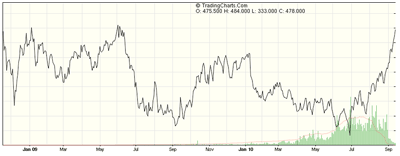It is the critical time of year in the corn market, and weather patterns are threatening to impact this year’s harvest, creating volatility and a chance for savvy traders to profit on the resulting price action.
The smoke has cleared from the June 30 planted acreage report, and the trade sold the numbers on corn after the report suggested 92.3 million acres of corn will be planted. The report earlier in the month said 90 million would be planted.
With normal yields of 158.7 bushels per acre and no change in corn usage or exports, ending stocks come the end of the new marketing year, August 31, 2012, would rise to almost 900 million bushels (mb) from 695 mb on the prior report.
The Growing Season
The report saw corn break more than $1 before pulling back up $1 since the report low 15 days ago. So what's up? Well, the market simply applied the 40-year-old adage that it's not what you plant, but what you grow. Weather and its impact on yields is the ultimate production-determining factor.
Even if more acres are planted, a dry season can cut production yields. On the other hand, a prime growing season may produce better yields on fewer acres.
Just a one-bushel-per-acre loss on the government yield estimates and ending stocks can drop under 500 mb, about a 40-day supply. Late planting dates due to a record wet spring leaves corn going into pollination. It's key yield-determining time through month end.
Current forecasts suggest a treacherous heat dome will cover the Midwest grain belt from July 15-23. Some suggest a record wet spring is now giving way to a much drier pattern, which would be very untimely for corn.
Here’s how corn prices played out last year:
How to Profit
Option players can consider buying the September corn at-the-money call and sell a $1 out-of-the-money call for 20 cents, or $1,000. (Prices at the time of writing—be sure to verify current pricing before entering any trade.)
It doesn't expire until the third Friday in August, taking you through the entire corn growing season. A change in the weather leaves plenty of time to get out and cut risk.
By Tim Hannagan, analyst, PFGBest


















